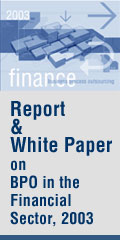|


|
Sharp decline in the disbursement levels of non banking financial companies (NBFC's)
CRISIL has observed a sharp decline in the disbursement levels of non banking financial companies
(NBFCs) over the past two months, as NBFCs have focused on repaying their maturing short-term
obligations to mutual funds (MFs). The decline in disbursements was as high as 70 per cent in one
case, with the average at around 50 per cent for CRISIL-rated NBFCs, pointing to the severity of the
business shrinkage.
While the going has been difficult for the sector, CRISIL nevertheless sees
NBFCs’ business and financial profiles generally stronger today than they were during the crisis of the
late 1990s. In addition, many NBFCs have strong parentage, enhancing their credit strength.
According to Ms. Roopa Kudva, Managing Director and Chief Executive Officer, CRISIL
“Despite increased delinquencies in NBFC portfolios, cash flows from existing assets will allow
maturing debt obligations to be met on time. However, the decline in business volume will mean a
further marginalisation of the sector, a trend that has been accelerating over the past few years as
banks have taken over the traditional NBFC stronghold of retail lending.”
CRISIL believes that the
NBFC business model will change over the long term, with a focus on product innovation, and a move
towards the originate-and-sell model.
NBFCs’ balance sheets have a significant asset-liability mismatch; more than 50 per cent of NBFCs’
borrowings have maturities of less than one year, while most of the assets have tenures of about three
years. Further, the dependence on MFs for short-term funding has been high: CRISIL-rated NBFCs’
estimated borrowings from MFs have increased to more than 45 per cent of total borrowing as of
September 30, 2008, from 30 per cent as on March 31, 2006.
Increasingly facing redemption
pressures, MFs are no longer lending to the NBFC sector, and are withdrawing their existing
exposures as these mature. The recent measures announced by the Reserve Bank of India (RBI),
allowing NBFCs increased access to funding, will indeed ease their debt servicing pressures, but will
not address the longer-term issue of business growth.
CRISIL has analysed the disbursement pattern of its 33 rated NBFCs, which represent 30 per cent of
the total NBFC sector. Most of these NBFCs, especially asset finance companies, have significantly
slowed down disbursements because of a lack of funds: the average monthly disbursements during
September and October are estimated to be half of disbursements during August. NBFCs’ share in the
overall retail finance space has reduced over the past few years as banks, with their superior size and
resource diversity, have achieved dominance: banks today make more than two-thirds of retail finance
disbursements, up from about 20 per cent in 2002.
CRISIL does not expect this trend to reverse.
Over the next few years, CRISIL expects NBFCs’ role to transform itself into one of innovation and
partnership. Says Mr. Tarun Bhatia, Head, Financial Sector Ratings, CRISIL, “As innovators,
NBFCs will build business models and incubate markets before the banks step in, and as partners
they will combine their origination capabilities
(This is press release of crisil dated November 10, 2008)
CLICK FOR Updates on Domestic Lending Rates
CLICK FOR SPECIAL SECTION ON GLOBAL FINANCIAL CRISIS
CLICK FOR MORE FEATURES & STORIES
|
|
|


